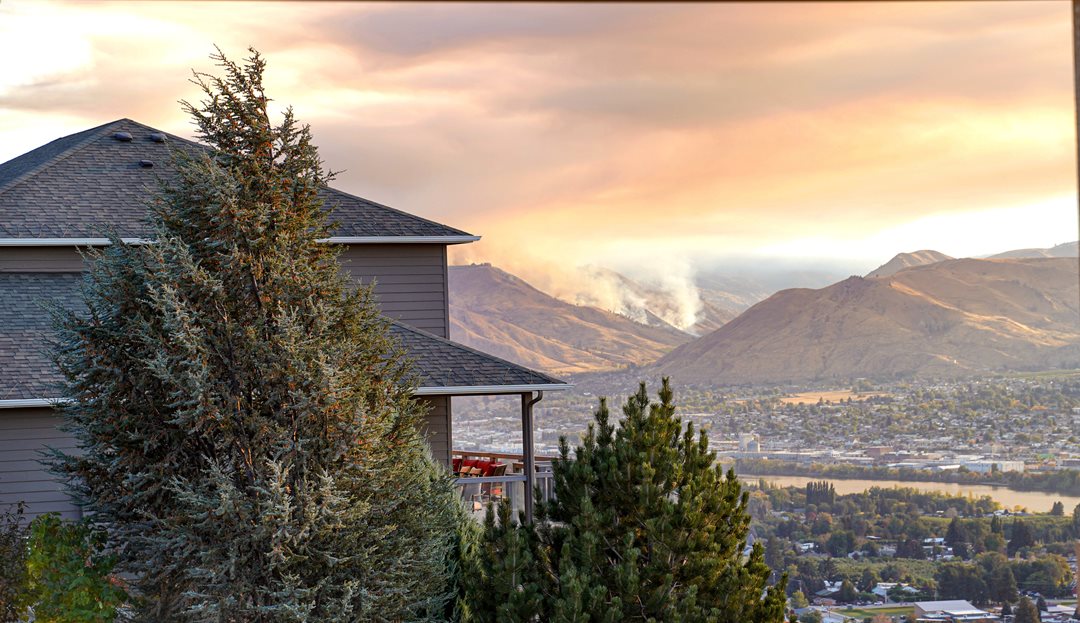Making your home fire-resilient | PEMCO
 Wildfires pose a significant threat to homes, especially as wildfire season becomes longer and more severe throughout the Pacific Northwest and beyond. Here at PEMCO, we take prevention seriously, and believe it can make a big difference when it comes to protecting your home, your family, and the things that matter most.
Wildfires pose a significant threat to homes, especially as wildfire season becomes longer and more severe throughout the Pacific Northwest and beyond. Here at PEMCO, we take prevention seriously, and believe it can make a big difference when it comes to protecting your home, your family, and the things that matter most.
There are several things you can do to mitigate wildfire damage by retrofitting your home with fire-resilient materials. Read on to learn more.
The first line of defense is always keeping fire from coming near your home with defensible fire perimeters, and eliminating any combustible materials near your home. This could look like creating fire breaks, such as breaking up your wooden fence with a metal gate, or putting cement or pavers up against your home's siding rather than mulch. The second line of defense is making your home more fire resilient. Here are some essential renovation projects, materials, and techniques to help protect your home from wildfires.
Ember-resistant vents
In the instance of a wildfire near you, embers can travel up to a mile. Installing ember-resistant vents and mesh screening can prevent embers from entering your home and igniting it from within. Use these ember-resistant solutions:
-
Mesh screens: Install 1/8-inch mesh screens over vents to prevent embers from entering.
-
Ember-resistant vents: Consider specialized vents designed to block embers while allowing airflow.
Fire-resistant roofing
The roof is one of the most vulnerable parts of a home during a wildfire. When replacing or upgrading your roof, consider these fire-resistant roofing options:
-
Metal roofing: Metal roofs are highly resistant to fire and can prevent embers from igniting.
-
Clay or concrete tiles: These materials are non-combustible and provide excellent protection against fire.
-
Asphalt shingles: Opt for class A fire-rated asphalt shingles for maximum fire resistance.
Non-combustible siding
Choosing the right siding can significantly reduce the risk of fire damage. Here are some effective options:
-
Fiber-cement siding: Made from a mix of cement and cellulose fibers, this siding is highly fire-resistant.
-
Stucco: Stucco is a non-combustible material that can withstand high temperatures.
-
Brick or stone veneer: These materials offer excellent fire resistance and durability.
Fire-resistant windows
Windows can be a weak point during a wildfire, allowing heat and embers to enter the home. Consider these upgrades:
-
Tempered glass: Tempered glass is stronger and more resistant to heat than regular glass.
-
Double-pane windows: Double-pane windows provide an extra layer of protection against heat and flames.
Fire-resistant decking
Decks can be a major fire hazard if not constructed with fire-resistant materials. Here are some options:
-
Composite decking: Made from a mix of wood fibers and plastic, composite decking is more fire-resistant than traditional wood.
-
Metal decking: Metal decking is non-combustible and provides excellent fire protection.
Fire-resistant landscaping
Proper landscaping can create a defensible space around your home and reduce the risk of fire spreading:
-
Fire-resistant plants: Choose plants that are less likely to ignite, such as succulents.
-
Rock or gravel: Use non-combustible mulch materials around your home instead of traditional bark or mulch. Pavers are another great option.
-
Clear vegetation: Maintain a clear zone of at least 30 feet around your home, free of flammable vegetation.
Fire-resistant fencing
Wooden fences can be flammable and act as a conduit for fire to reach your home. Opt for these fire-resistant fencing materials:
-
Metal fencing: Metal fences are non-combustible and can help prevent the spread of fire.
-
Masonry walls: Masonry walls made of brick or stone can provide a strong barrier against fire.
Fire-resistant construction techniques
Incorporating fire-resistant construction techniques can further enhance your home's protection:
-
Sealed eaves and soffits: Ensure eaves and soffits are sealed to prevent embers from entering.
-
Fire-resistant insulation: Use insulation materials that are less likely to ignite, such as mineral wool.
-
Proper ventilation: Ensure proper ventilation to reduce the risk of heat buildup and fire spread.
By implementing some of these renovation projects, materials, and techniques, you can reduce the risk of wildfire damage to your home, which is added peace of mind for both you and your loved ones.
Stay proactive and retrofit your home with fire-resilient materials. And remember, you aren’t alone. When you work with your neighbors to build a wildfire-resilient community, you are spreading the impact of prevention.
Note: Following these wildfire mitigation and prevention tips does not guarantee insurance coverage from PEMCO.
Share on social media